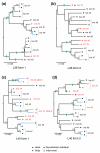Chaetognath transcriptome reveals ancestral and unique features among bilaterians
- PMID: 18533022
- PMCID: PMC2481426
- DOI: 10.1186/gb-2008-9-6-r94
Chaetognath transcriptome reveals ancestral and unique features among bilaterians
Abstract
Background: The chaetognaths (arrow worms) have puzzled zoologists for years because of their astonishing morphological and developmental characteristics. Despite their deuterostome-like development, phylogenomic studies recently positioned the chaetognath phylum in protostomes, most likely in an early branching. This key phylogenetic position and the peculiar characteristics of chaetognaths prompted further investigation of their genomic features.
Results: Transcriptomic and genomic data were collected from the chaetognath Spadella cephaloptera through the sequencing of expressed sequence tags and genomic bacterial artificial chromosome clones. Transcript comparisons at various taxonomic scales emphasized the conservation of a core gene set and phylogenomic analysis confirmed the basal position of chaetognaths among protostomes. A detailed survey of transcript diversity and individual genotyping revealed a past genome duplication event in the chaetognath lineage, which was, surprisingly, followed by a high retention rate of duplicated genes. Moreover, striking genetic heterogeneity was detected within the sampled population at the nuclear and mitochondrial levels but cannot be explained by cryptic speciation. Finally, we found evidence for trans-splicing maturation of transcripts through splice-leader addition in the chaetognath phylum and we further report that this processing is associated with operonic transcription.
Conclusion: These findings reveal both shared ancestral and unique derived characteristics of the chaetognath genome, which suggests that this genome is likely the product of a very original evolutionary history. These features promote chaetognaths as a pivotal model for comparative genomics, which could provide new clues for the investigation of the evolution of animal genomes.
Figures








Similar articles
-
Translational machinery of the chaetognath Spadella cephaloptera: a transcriptomic approach to the analysis of cytosolic ribosomal protein genes and their expression.BMC Evol Biol. 2007 Aug 28;7:146. doi: 10.1186/1471-2148-7-146. BMC Evol Biol. 2007. PMID: 17725830 Free PMC article.
-
Identification of chaetognaths as protostomes is supported by the analysis of their mitochondrial genome.Mol Biol Evol. 2004 Nov;21(11):2122-9. doi: 10.1093/molbev/msh229. Epub 2004 Aug 11. Mol Biol Evol. 2004. PMID: 15306659
-
Careful with understudied phyla: the case of chaetognath.BMC Evol Biol. 2008 Sep 17;8:251. doi: 10.1186/1471-2148-8-251. BMC Evol Biol. 2008. PMID: 18798978 Free PMC article.
-
Phylogeny: the continuing classificatory conundrum of chaetognaths.Curr Biol. 2006 Aug 8;16(15):R593-6. doi: 10.1016/j.cub.2006.07.006. Curr Biol. 2006. PMID: 16890517 Review.
-
Integrating natural history collections and comparative genomics to study the genetic architecture of convergent evolution.Philos Trans R Soc Lond B Biol Sci. 2019 Jul 22;374(1777):20180248. doi: 10.1098/rstb.2018.0248. Epub 2019 Jun 3. Philos Trans R Soc Lond B Biol Sci. 2019. PMID: 31154982 Free PMC article. Review.
Cited by
-
High cryptic diversity across the global range of the migratory planktonic copepods Pleuromamma piseki and P. gracilis.PLoS One. 2013 Oct 22;8(10):e77011. doi: 10.1371/journal.pone.0077011. eCollection 2013. PLoS One. 2013. PMID: 24167556 Free PMC article.
-
SLIDR and SLOPPR: flexible identification of spliced leader trans-splicing and prediction of eukaryotic operons from RNA-Seq data.BMC Bioinformatics. 2021 Mar 22;22(1):140. doi: 10.1186/s12859-021-04009-7. BMC Bioinformatics. 2021. PMID: 33752599 Free PMC article.
-
The falsifiability of the models for the origin of eukaryotes.Curr Genet. 2011 Dec;57(6):367-90. doi: 10.1007/s00294-011-0357-z. Epub 2011 Oct 19. Curr Genet. 2011. PMID: 22008946 Review.
-
Evolutionary Insights into RNA trans-Splicing in Vertebrates.Genome Biol Evol. 2016 Mar 10;8(3):562-77. doi: 10.1093/gbe/evw025. Genome Biol Evol. 2016. PMID: 26966239 Free PMC article. Review.
-
The genomic origin of the unique chaetognath body plan.Nature. 2025 Aug 13. doi: 10.1038/s41586-025-09403-2. Online ahead of print. Nature. 2025. PMID: 40804517
References
-
- Putnam NH, Srivastava M, Hellsten U, Dirks B, Chapman J, Salamov A, Terry A, Shapiro H, Lindquist E, Kapitonov VV, Jurka J, Genikhovich G, Grigoriev IV, Lucas SM, Steele RE, Finnerty JR, Technau U, Martindale MQ, Rokhsar DS. Sea anemone genome reveals ancestral eumetazoan gene repertoire and genomic organization. Science. 2007;317:86–94. doi: 10.1126/science.1139158. - DOI - PubMed
-
- Seo HC, Edvardsen RB, Maeland AD, Bjordal M, Jensen MF, Hansen A, Flaat M, Weissenbach J, Lehrach H, Wincker P, Reinhardt R, Chourrout D. Hox cluster disintegration with persistent anteroposterior order of expression in Oikopleura dioica. Nature. 2004;431:67–71. doi: 10.1038/nature02709. - DOI - PubMed
-
- Hyman LH. The Invertebrates, Vol 5, Smaller Coelomate Groups. New York: McGraw-Hill; 1959.
Publication types
MeSH terms
LinkOut - more resources
Full Text Sources
Miscellaneous

